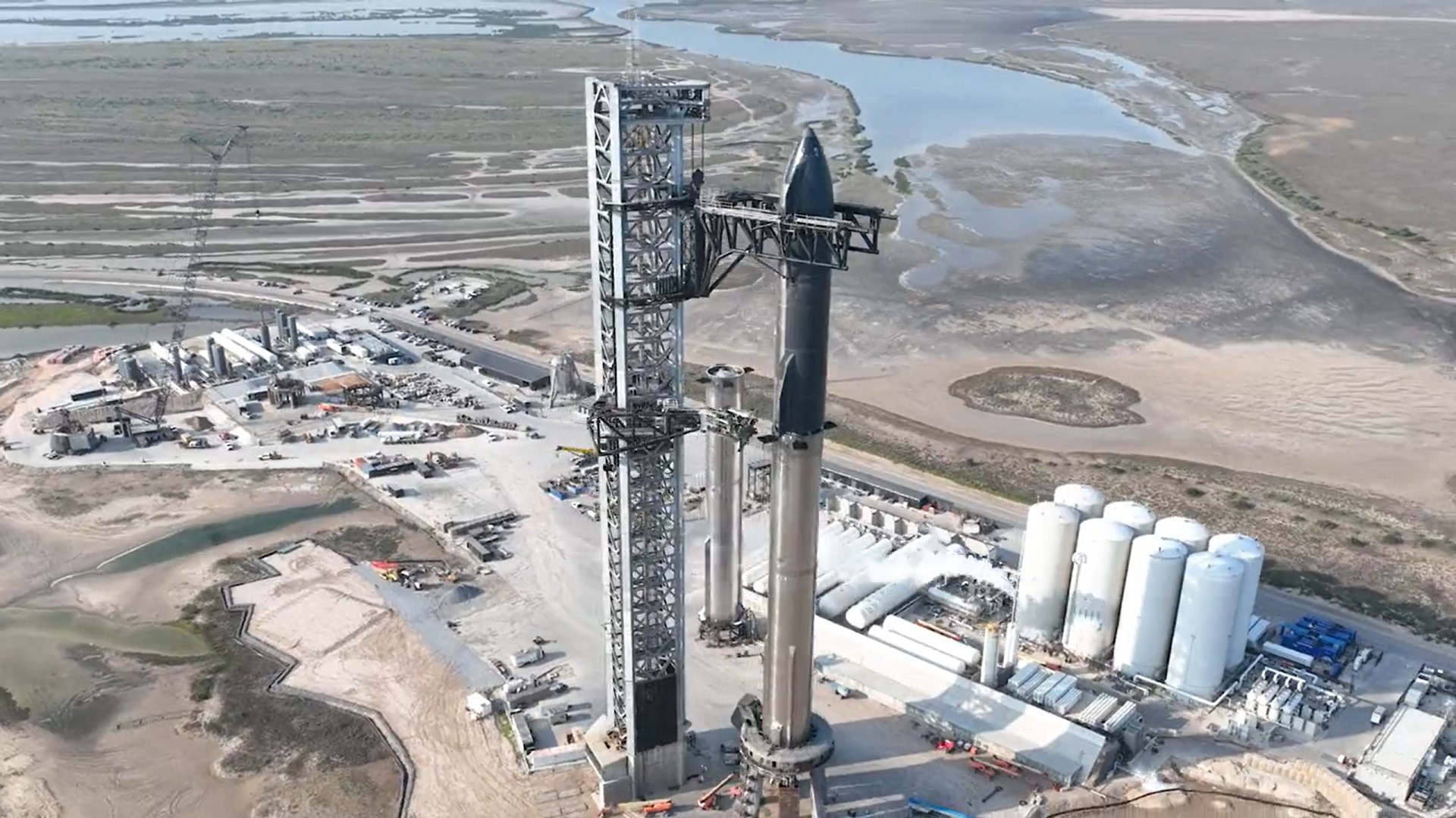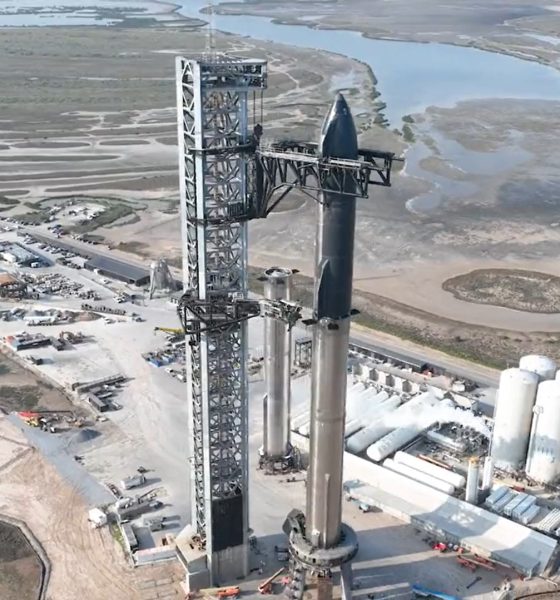

News
SpaceX stacks Starship and Super Heavy booster for “wet dress rehearsal” test
For the third time in three months, SpaceX has fully assembled Starship 24 and Super Heavy Booster 7 after another period of separate tests, repairs, and modifications.
Measuring around 120 meters (~390 ft) tall from ship tip to booster tail, the fully-stacked rocket is again the largest ever assembled. Compared to the Falcon 9 and Falcon Heavy rockets SpaceX currently operates, Starship is far larger. It’s also meant to be fully reusable, while the Falcon family – which expends its orbital upper stage – is roughly 80% reusable. If SpaceX can meet its technical goals, Starship could eventually cost around a magnitude less to launch than Falcon while carrying roughly 5-20 times more payload per launch. In short, it could revolutionize the cost of access to orbit.
Combined with orbital refilling, the ability to transfer propellant between Starships, reusable Starships could also radically exceed Falcon 9 or even Falcon Heavy’s expendable performance. But first, SpaceX needs to make sure that Starship can reach orbit at all.
Compared to Ship 20 and Booster 4, earlier prototypes that were also fully stacked a few times in 2021 and early 2022 before their retirement, Ship 24 and Booster 7 are closer to supporting Starship’s first orbital launch attempt. After their latest full-stack milestone, they could be just a few major tests away from being cleared for flight.
The update that's rolling out to the fleet makes full use of the front and rear steering travel to minimize turning circle. In this case a reduction of 1.6 feet just over the air— Wes (@wmorrill3) April 16, 2024
“According to CEO Elon Musk and a NASA official, the last major standalone test between Booster 7 and flight readiness is a full 33-engine static fire. Together, B7’s 33 Raptor 2 engines could produce up to 7600 tons (16.7 million lbf) of thrust at sea level, likely making Starship the most powerful rocket stage in the history of spaceflight.
A wet dress rehearsal is a routine test conducted before a rocket launch and is generally designed to simulate every aspect of a launch save for engine ignition and liftoff. Most importantly, that involves fully filling the rocket with propellant and passing all of the checks the same rocket would need to pass to be cleared for launch. The first full-stack WDR will test Starbase’s launch facilities just as much as Booster 7 and Ship 24.”
Teslarati.com – January 9th, 2023
The January 9th assembly of B7 and S24 confirms that the WDR will likely occur first, as conducting the first 33-Raptor Super Heavy static fire while fully stacked would unnecessarily risk the Starship. Ship 24 could fly on a future booster if B7 does not pass (or survive) proof testing. More likely than not, Ship 24 will be removed from Booster 7 after WDR testing, freeing Super Heavy for one last round of standalone static fire testing. If that testing clears Booster 7, Ship 24 will be reinstalled – possibly for the last time.
While hardware challenges continue to trump paperwork, an FAA launch license is another significant hurdle standing between SpaceX and Starship’s orbital launch debut. SpaceX and the FAA are in the middle of hammering out the details of such a license, which is partially contingent upon the completion of dozens of “mitigation” measures. Because Starship’s unprecedented size elevates the risk it could pose to local residents, it’s likely that that license is also contingent upon results from ground tests and will be one of the last gates to be lifted.
SpaceX has three windows that could be used for B7/S24 full-stack testing this week: two from 8am to 8pm CST on January 11th and 12th and one from 8am to 4pm on January 13th. CEO Elon Musk says that Starship could be ready for its first orbital launch attempt as early as late February or March 2023.

Cybertruck
Tesla Cybertruck undergoes interior mod that many owners wanted

Tesla Cybertruck is significantly different from traditional pickups on the market in a lot of ways. However, one feature that was recently modified with its interior was a highly requested characteristic that is present in other trucks, but was void from Cybertruck.
Tesla went with a five-seat configuration with Cybertruck: two in the front and three in the back. The spacious interior is matched with plenty of storage, especially up front, as a pass-through, center console, and other storage options, but some Tesla fans wanted something different: bench seating.
Bench seating is popular in many full-size pickups and allows three passengers to sit up front. The middle seat is usually accompanied by a fold-down storage unit with cupholders.
Tesla decided to opt for no bench seating up front, despite the fact that it equipped bench seating in the unveiling in 2019. Interior photos from the unveiling event from nearly six-and-a-half years ago show Tesla had originally planned to have a six-seat configuration.
This was adjusted after the company refined the design:

(Tesla Cybertruck interior configuration in 2019)
Despite Tesla abandoning this design, it does not mean owners were willing to accept it. One owner decided to modify their Tesla Cybertruck interior to equip that third seat between the driver’s and passenger’s thrones.
The fit is snug, and while it looks great, it is important to remember that this does not abide byregulations, as it would require an airbag to be technically legal. Please do not do this at home with your own Cybertruck:
- Credit: @blueskykites
- Credit: @blueskykites
- Credit: @blueskykites
The Cybertruck is a popular vehicle in terms of publicity, but its sales have been underwhelming since first delivered to customers back in 2023. It’s hard to believe it’s been out for two-and-a-half years, but despite this, Tesla has not been able to come through on its extensive order sheet.
This is mostly due to price, as Cybertruck was simply not as affordable as Tesla originally planned. Its three configurations were initially priced at $39,990, $49,990, and $69,990. At release, Cybertruck was priced above $100,000.
This priced out many of those who had placed orders, which is the main reason Cybertruck has not lived up to its expectations in terms of sales. The adjustments to the specific features, like the removal of the bench seat, likely did not impact sales as much as pricing did.
This modification shows some creativity by Tesla owners, but also shows that the Cybertruck could always be the subject of a potential refresh to include some of these features. Tesla routinely adjusts its vehicle designs every few years, so maybe the Cybertruck could get something like this if it chooses to refresh its all-electric pickup.
Elon Musk
Tesla CEO Elon Musk drops massive bomb about Cybercab
“And there is so much to this car that is not obvious on the surface,” Musk said.

Tesla CEO Elon Musk dropped a massive bomb about the Cybercab, which is the company’s fully autonomous ride-hailing vehicle that will enter production later this year.
The Cybercab was unveiled back in October 2024 at the company’s “We, Robot” event in Los Angeles, and is among the major catalysts for the company’s growth in the coming years. It is expected to push Tesla into a major growth phase, especially as the automaker is transitioning into more of an AI and Robotics company than anything else.
The Cybercab will enable completely autonomous ride-hailing for Tesla, and although its other vehicles will also be capable of this technology, the Cybercab is slightly different. It will have no steering wheel or pedals, and will allow two occupants to travel from Point A to Point B with zero responsibilities within the car.
Tesla shares epic 2025 recap video, confirms start of Cybercab production
Details on the Cybercab are pretty face value at this point: we know Tesla is enabling 1-2 passengers to ride in it at a time, and this strategy was based on statistics that show most ride-hailing trips have no more than two occupants. It will also have in-vehicle entertainment options accessible from the center touchscreen.
It will also have wireless charging capabilities, which were displayed at “We, Robot,” and there could be more features that will be highly beneficial to riders, offering a full-fledged autonomous experience.
Musk dropped a big hint that there is much more to the Cybercab than what we know, as a post on X said that “there is so much to this car that is not obvious on the surface.”
And there is so much to this car that is not obvious on the surface
— Elon Musk (@elonmusk) January 2, 2026
As the Cybercab is expected to enter production later this year, Tesla is surely going to include a handful of things they have not yet revealed to the public.
Musk seems to be indicating that some of the features will make it even more groundbreaking, and the idea is to enable a truly autonomous experience from start to finish for riders. Everything from climate control to emergency systems, and more, should be included with the car.
It seems more likely than not that Tesla will make the Cybercab its smartest vehicle so far, as if its current lineup is not already extremely intelligent, user-friendly, and intuitive.
Investor's Corner
Tesla Q4 delivery numbers are better than they initially look: analyst
The Deepwater Asset Management Managing Partner shared his thoughts in a post on his website.

Longtime Tesla analyst and Deepwater Asset Management Managing Partner Gene Munster has shared his insights on Tesla’s Q4 2025 deliveries. As per the analyst, Tesla’s numbers are actually better than they first appear.
Munster shared his thoughts in a post on his website.
Normalized December Deliveries
Munster noted that Tesla delivered 418k vehicles in the fourth quarter of 2025, slightly below Street expectations of 420k but above the whisper number of 415k. Tesla’s reported 16% year-over-year decline, compared to +7% in September, is largely distorted by the timing of the tax credit expiration, which pulled forward demand.
“Taking a step back, we believe September deliveries pulled forward approximately 55k units that would have otherwise occurred in December or March. For simplicity, we assume the entire pull-forward impacted the December quarter. Under this assumption, September growth would have been down ~5% absent the 55k pull-forward, a Deepwater estimate tied to the credit’s expiration.
“For December deliveries to have declined ~5% year over year would imply total deliveries of roughly 470k. Subtracting the 55k units pulled into September results in an implied December delivery figure of approximately 415k. The reported 418k suggests that, when normalizing for the tax credit timing, quarter-over-quarter growth has been consistently down ~5%. Importantly, this ~5% decline represents an improvement from the ~13% declines seen in both the March and June 2025 quarters.“
Tesla’s United States market share
Munster also estimated that Q4 as a whole might very well show a notable improvement in Tesla’s market share in the United States.
“Over the past couple of years, based on data from Cox Automotive, Tesla has been losing U.S. EV market share, declining to just under 50%. Based on data for October and November, Cox estimates that total U.S. EV sales were down approximately 35%, compared to Tesla’s just reported down 16% for the full quarter. For the first two months of the quarter, Cox reported Tesla market share of roughly a 65% share, up from under 50% in the September quarter.
“While this data excludes December, the quarter as a whole is likely to show a material improvement in Tesla’s U.S. EV market share.“











